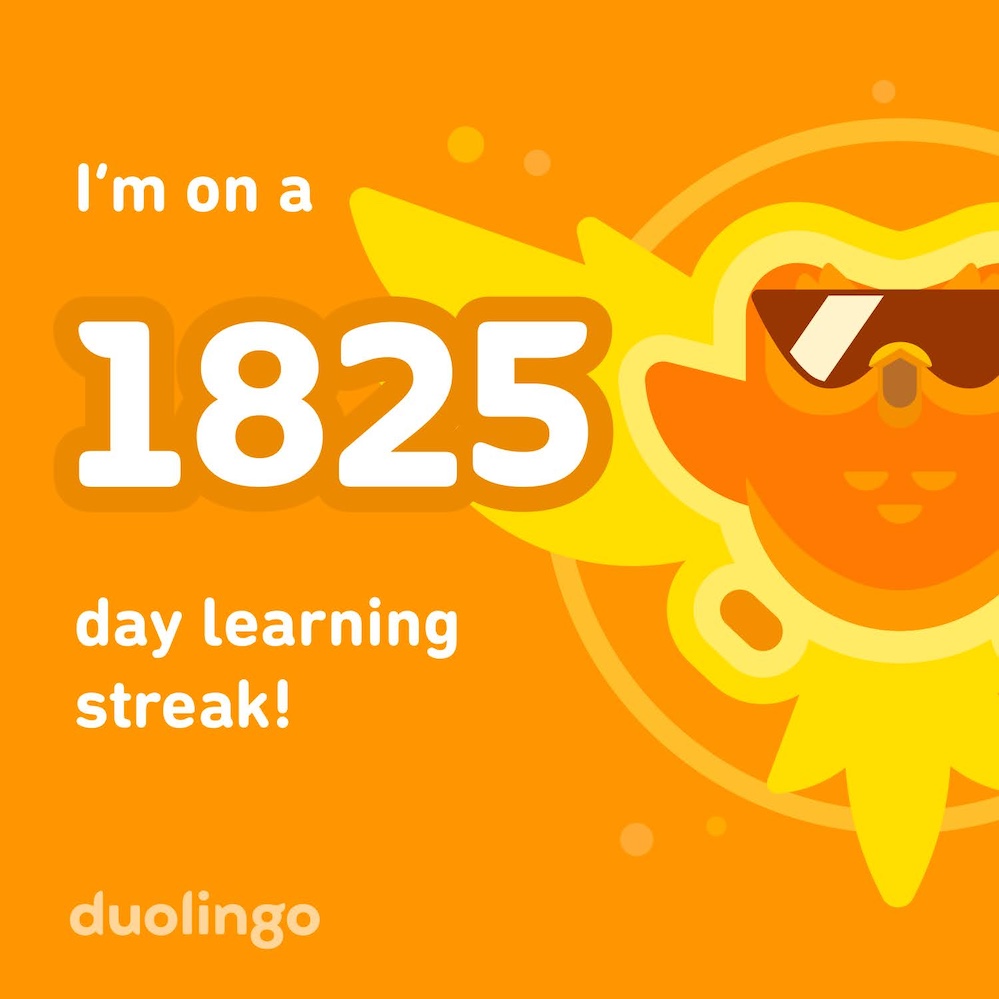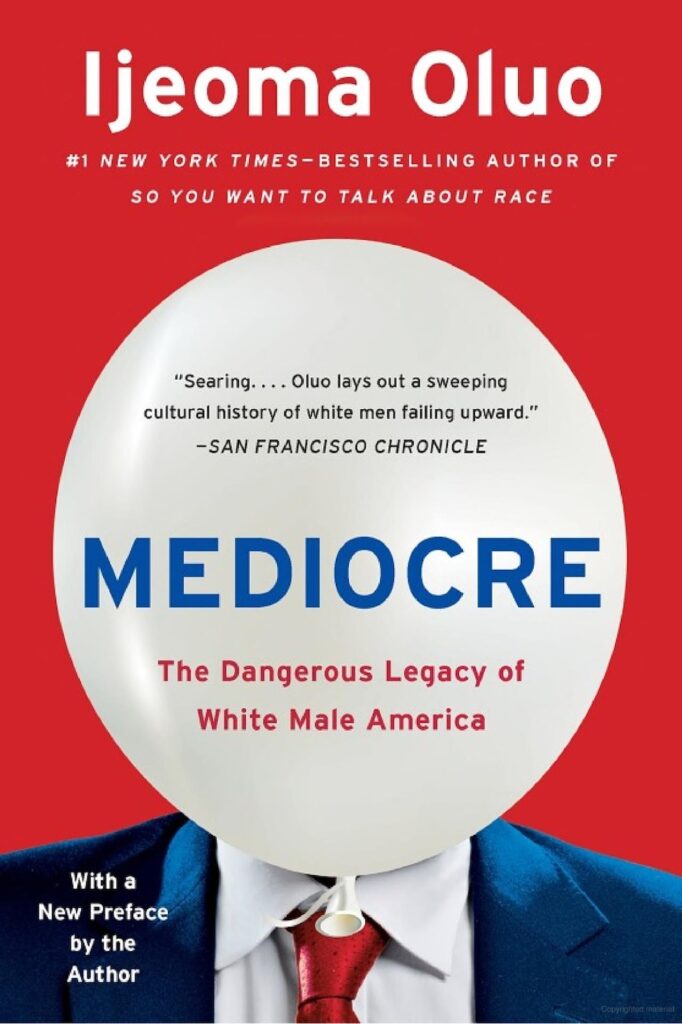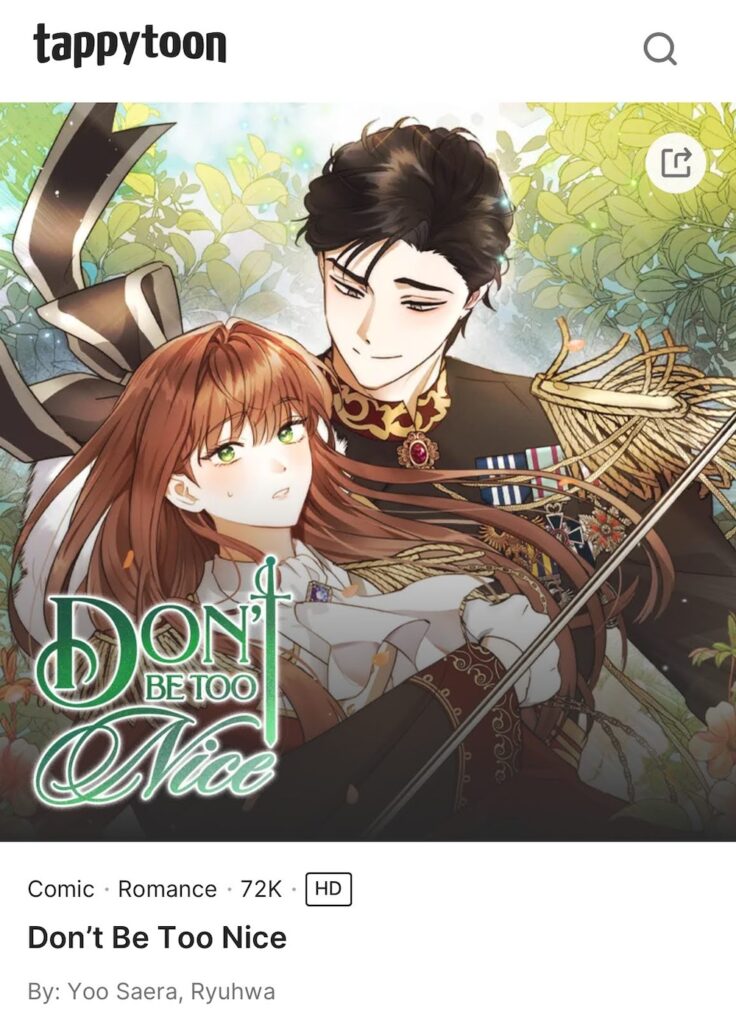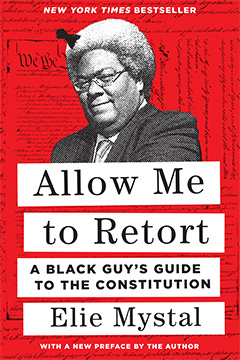
I am… a fanatic.
This is the five year mark! I feel lucky to have access to lessons like this.

Hints on how A.E. Graves spends her imaginary spare time

I am… a fanatic.
This is the five year mark! I feel lucky to have access to lessons like this.

Mediocre: The Dangerous Legacy of White Male America
by Ijeoma Oluo
published by Seal Press / Hachette
2020 (updated forward 2021)
I sought out this book while looking for an explanation beyond my own theories as to why a few male friends were convinced that they deserved certain things (jobs, promotions, praise) when they didn’t appear to have done anything in particular to earn them. (One in particular emphasized his “Americanness” (which wasn’t what he meant) in a way that was unnerving, as he had no accomplishments or education in the field he wanted to break into, while his competition appeared to have degrees, resumes, projects to show, etc. So, I was free to interpret THAT.) I picked up this book looking for another, better researched view on this.
Oluo starts her history with tales of the American West and the subjugation of its original people, but really digs in with contemporary stories of the perils of world views centered on white maleness. From white male allies who make other groups’ civil rights movements all about themselves, or those who are allies only when it directly benefits them (Biden’s chummy behavior with segregationists is remarkably laid out here), to the zeal of B-bros who attack anyone who won’t fall in line to support policies which prioritize their needs while maintaining obstacles to other groups in order maintain their own advantages, Oluo presents a clear pattern of self-serving, obstructive-to-meaningful-progress behavior.
Though I had been generally familiar with bans on married women having paid work, Oluo’s book cataloged the number of states that put bans on the books, including bans during the Great Depression on two-government-job households (which couldn’t be more directed at removing lower paid women from jobs). This book also introduced me to some of the anti-employed-women propaganda paid for by tax dollars, plus the pro-employed-in-war-time propaganda that had to reverse its own threats to happiness that had been promoted so zealously earlier. The way people of color and women were discarded after answering the call to scale up industry is sadly consistent with a system that believes the best of everything — and even the most ordinary version of everything — is the natural property of white men, regardless of their interest or ability.
Writing about the hatred that anyone who points out these clear patterns of bias receives, and the faux-neutrality that white men are somehow awarded (as if being a white man isn’t an identity) is painful and familiar to anyone who exists online or reads news written about any group other than white men. This work took a toll on the author, and the details of the hate mail she has received for writing on this topic at all are harrowing – and prove her points about the white men who aggressively enforce that their point of view is the only one that ever matters.
While her updated introduction reflects upon the nightmare that was a certain former US president, Oluo chose not to centralize or even frequently name him, so you can pick this up without that dread!
Oluo has a clear and accessible writing style, which I enjoyed. The sensitive topic of pervasive white male centrism is a massive ‘elephant in the room’ that triggers shocking responses in our culture, and Oluo shares her observations on this topic thoughtfully. I’m glad I’ve kept this book on my reading list, and finally picked it up!
Don’t Be Too Nice
by Yoo Saera, Ryuhwa
published by Tappytoon (20 chapters so far)
2024 – ongoing

My favorite new comic charmed me so quickly, I was caught off guard – it becomes eventful immediately, in an engaging way.
We meet former mage and knight Rustica Genas after she has fallen on hard times. She was a promising teenage battle leader close to power, but after years of progress-free war, she wanted the Caleta Empire to change its approach. The impenetrable Great Barrier spewing monsters remained unchanged, and countless people had been consumed by it – including her beloved parents. Her unwanted advice on a new approach to her Emperor leaves her fired, magically disabled, and miserable.
Her efforts to fade into obscurity in a small town far from the capital seem to be working after four years, but a drunken, one night stand saddles her with an angel-faced, excessively friendly, former child-soldier. Once he disappears (in a magical manner), there is big news. The Great Barrier contains an opening (!), there are countries on the other side of it (!!), and the Emperor wants her to be a diplomat, even with her current weaknesses (!!!).
What the hell?
Rustica (Rue to her friends) rolls with it… and on the other side of the Great Barrier, things take a turn for the fantastic. Well, awkward first, and THEN fantastic.
The story moves FAST, and we get to see what life is like through Rue’s eyes in an unknown, highly developed empire that rivals her own. Life as a diplomat from an “enemy” nation isn’t easy, and her team is completely certain she is being bullied by the emperor on this new side. But the revelations about how the rest of the world sees her home empire come fast, and revelations about how she lost her abilities change Rue’s world view.
I picked this up and wouldn’t put it down until I’d read all available episodes. I love the pacing! I adore the ‘enemy’ emperor! I love the humor panels! (I need to also have the word ‘pitiful’ hovering beside me at various points during the day.) The story is action-packed and developing quickly. I’m eager for more.

Allow Me to Retort: A Black Guy’s Guide to the Constitution
by Elie Mystal
published by the New Press
2022
This is the most fun law-themed book I’ve read in ages, delivering just what I hoped from the witty and passionate commentator, Elie Mystal.
For those of us who work in law and have copies of the U.S. Constitution in our homes, we live in discomfort. Because: we’ve read the thing. And it’s… not the best experience. When I get to the parts that tell me, a woman of color, that I should be counted as 3/5ths of a person, or it takes until the 19th Amendment to get a right to vote, I don’t exactly feel the warm fuzzies. And when I routinely read Supreme Court decisions, especially the parts written by the conservatives who think that we should interpret the document as the original writers would have liked, locking our values in a prior century, I am ANGRY.
Elie Mystal feels all of that anger AND he writes about it in a very engaging, pop-culture-reference-friendly, fun to read way!
Chapters have titles like, “Canceling Trash People is Not a Constitutional Crisis.” (Yesssssss!). The so-called originalists and their only-originalist-if-I-get-what-I-want hypocrisy is CALLED OUT. He calls out so much B.S. that passes for legal thought, but is really just selective, self-serving nonsense. It is REFRESHING – especially with so many people breathless about the Constitution in a way that fails to address its limitations.
This is topical, thoughtful, well-written, relevant, and might make you cackle loudly and alarm others nearby. I highly recommend this book.

So, it turns out that having espresso drinks (almond milk lattes, to be precise) at 7:50AM as part of a light breakfast can inspire me to wake up much earlier than usual. I don’t mean minutes after I drink them, but the following morning. By perhaps 2 hours?
I retain a deep personal suspicion that my uphill neighbor’s espresso-drinking habits are more relevant to my sleep, because she is the one in her kitchen slamming cabinets at 2:30AM, so I’ll need to do some more ‘science’ to be sure. But being up at 3:30 or 4 happened a few days in a row after the rare days I was early enough to buy an espresso drink, so that’s data I must cope with.
(I say espresso-drink mornings are rare, but the perky, caffeinated, cool barista remembers my name, so my position may not be credible.)
My sleep is precious to me, and I seem to need a higher quality of it than I had earlier in life. If you see me after a few days of sub-six-hours nights, you’ll understand quickly the jokes about it being called, “beauty sleep.” [This is only useful at Halloween.]

I enjoyed a truly wonderful staycation (stay at home vacation) over the Independence Day Holiday week. Part of what made it wonderful was that I resisted the urge to MAXIMIZE the time off.
One of my commute pals described her days off, and we both acknowledged that we suffer the psychological strain of leisure panic: the sense of having so little time off that we feel we Must.Do.Something.Amazing with our time off. Which… kind of defeats the purpose of having time off? Yet WE DO THIS. We leave work or wake up on our first day off with a goal-oriented sensibility. As if we have been programmed this way. Perhaps it doesn’t help that people are more likely to ask WHAT we did during the break (implying we should have done something?) rather than how it was (FANTASTIC, and all the more fantastic when I didn’t leave the house!).
I achieved a sort of balance during that time: I did plenty of fun things and I LOUNGED AROUND intensely. It was… so good. And it was so strange to see what I look like when I’ve had a full night’s sleep!
Some of my leisure was “busy.” There was a long walk / food /good conversation with friends; the PRIDE parade; medical appointments, lab tests, prescriptions, and so on (during which I had an honest conversation with a medical assistant about what people (like me) who work in law are like, and how she is a good friend for pressing her lawyer friends to sit on a beach with an umbrella-containing beverage and BE STILL); spa time; reading; writing; painting, and buying paint; minor chores; a little bit of online training to meet some arbitrary software deadlines; exploring the City on foot to visit a new place… But I took extra days off, so there was time for all those things to be spread thinly between even longer pajama hours.
My most serious commitment was to eating. The regional origins of the many types of foods I consumed include: Brazil (origin of the açai bowl, interpreted by Reveille), the Yucatan (Cochinita), Indonesia (Rasa Rasa), France (Grand Creperie), Ethiopian (Tadu), South Indian (I made fresh tomato rasam myself PLUS ordered in from Udupi Palace), Taiwanese (a gorgeous ube coconut milk latte boba from Boba Guys), Japanese (Sakesan plus homemade miso soups)… I didn’t repeat any restaurants (or shops!) from my artist pal’s recent visit, to my own surprise. Eating my way through the City in an unplanned way is a wonderful thing, any time!
There were many hours of staying at home in soft clothes and sitting still. Thinking. Watching the fog go out and return. Moving slowly. Drinking tea. Going back to bed after getting up too early. Having UNINTERRUPTED THOUGHTS. It was so… good.
(Even now, on this foggy Saturday afternoon, I am wearing soft , fastener-free clothes, have my hair in a bun above a makeup-free face. Topical caffeine is being absorbed by the bags under my eyes, while a salicylic acid sticker lies on emerging acne. So.NOT.photogenic! So comfy. I’ve heard gorgeous, presentable people described as making their great looks appear effortless. Please note that you really don’t want to see what my version of ‘effortless’ looks like! [evil, non-photogenic laughter])
As Independence Day weekend ended, and I began to dwell on what awaited me at work, I knew what to do: I ordered in fresh veggie sushi, sipped junmai ginjo sake out of a pretty glass, and read a new Korean comic. I was delighted for hours, with NO time wasted wondering about what my laptop would do when I turned it on. [happy sigh]. I hope this practice will allow me to JUST REST more (and more) often. And if anyone asks, I’ll say my weekend was GREAT, and I rested. Because that’s an achievement worth disclosing.
The Marvels
published by Marvel Entertainment (which feels self referential, but isn’t)
2023
[Me, shouting:] THIS IS AN ACTION COMEDY. Viewers laughed loudly in the theater with delight at appropriate moments when I saw it! I enjoyed it. It was intentionally silly. It was perfectly FINE.
But whoever was responsible for most of the ad campaign should be interrogated and maybe have to spend a few years locked up with Loki, or perhaps reading rival DC’s hate mail.
The film previews were misleading. Maybe the ads came out during the writers-strike or were the work of an evil intern, but they featured dead Avenger flashbacks about fighting great evil, rather than costumed musical numbers involving a hot prince singing to Captain Marvel while she dances in a ballgown-version of her battle costume. (This was a surprise worth saving to delight my fellow movie-goers, but STILL.)
Captain Marvel herself doesn’t seem to be having fun through much of the film, as the weight of possibly being a war criminal weighs heavily on her (ooopsie). Luckily, Ms. Marvel is having enough fun for everyone. And Monica Rambeau is grounded, consistent, and capable, playing it straight between star-struck Ms. Marvel and gloomy Captain Marvel.
If you like action hero comedies with mismatched buddies, disapproving parents, musical numbers, hot princes (hello, Park Seo-Jun!), secret marriages, flerkin kittens consuming Nick Fury’s staff, fangirls, and very poorly timed body swapping, this is a ‘light romp’ in superhero-dom that you might enjoy.
Polite Society
published by Focus Features
2023
This is an action comedy about a younger sister who doesn’t want to lose her supportive older sister to some smooth-talking wanker with a blatantly evil mother.
Does the younger sister misinterpret some social signals? Sure. Do her parents listen? No. Is she doing some very humiliating things while barking up the wrong tree and undermining her own cause? Yikes, yes. But she truly loves her sister, and is willing to go to outrageous lengths to stop her marriage.
Who can resist great fight-scenes between women dressed up for wedding? (I can’t.)
It is a sweet tale of sisterly love featuring dramatic physical fighting while wearing great outfits. It delivers what the preview promises.
The streetcar that I almost-finished the watercolor study of passed me Monday evening, and I was all, “HEY!”
I felt rather… proprietary towards it. Friendly, but also with a sense of ownership.
Dune
published by Warner Brothers
2021 (Part 2) 2024
The most beautiful science fiction films I’ve seen recently are these two films. Based on books by Frank Herbert, they tell a story of extractive settler colonialism, in which one feudal family is assigned by the emperor to rule a colony, but this leaves them vulnerable to the jealous emperor’s sabotage. Instead of being fully destroyed, the survivors foment an uprising that takes control of the substance that makes intergalactic travel possible, which threatens to undo the emperor completely.
Dune (part 1) shows the fall of that sabotaged feudal family, House Atreides. Dune Part 2 shows the beginning of uprising against the emperor’s go-to saboteurs, House Harkonnen, which will lead to war for the galactic empire itself.
The architecture is striking; the scale of it, the focus on shade and shelter, the efforts to shape the machine-like city to withstand sandstorms… The vehicles are impressive, with the vast scale that space would logically lead to (though landing such craft on planets with gravity seems less practical from an engineering standpoint, and more as a display of power toward unwilling subjects). The dragonfly-like craft are especially pleasing…
The acting is GOOD. If you’ve seen prior versions of this story on tv or film, you’ve seen both sincere efforts and cartoonish camp. This story plays it straight; the actor playing Paul Atreides is young enough to pull off the role of a conflicted youth persuasively, rather than being played by a full adult with painted rosy cheeks who is bigger than the people referring to him as ‘the little one;’ the villains remain over the top, but in a properly menacing way, more as plausible abusers of power than merely as monsters in appearance.
There are many things to admire, including the scale and pomp of many large gatherings, and the parts of the story that are simply about a boy and his mother trying to survive. The story scales up and down without losing the narrative. Technology scales from space weapons to knives, and still works seamlessly.
It’s really lovely to watch. You’ll need time – these are long movies – but there is a lot of story to cover in these books, and it never hurts to spend time looking at the beautiful patterns wind makes on sand – or how spaceships look when they explode in flames.